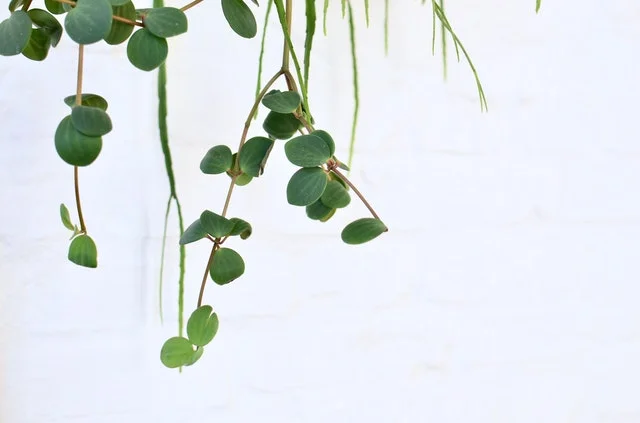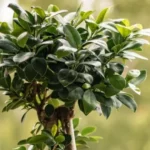Table of Contents
Facts About The Peperomia Prostrata Plant
The peperomia prostrata plant is known by a few names, including “string of turtles”, “string of hearts”, and “magic marmer”.
This greenery is a slow-growing perennial succulent plant that belongs to the Piperaceae family. The prostrata is a miniature form of the peperomia plant. It has small fleshy leaves that only grow to a quarter of an inch wide.
With its creeping trails of leaves and veins, the entire plant can grow to be about four inches wide and between one and four inches tall.
This particular perennial is fairly uncommon. It is native to Brazilian rainforests where its veins, colored anywhere from white to maroon, can be found overflowing over the ground and around other plants.
These leafy vine-like plants produce beautiful white flowers attached to flower spikes. This can make them wonderful ornamental plants inside the home.
When indoors, they are often placed in hanging baskets, where the veins, leaves, and flowers, may overflow the containers, giving the pots a lovely, full appearance.
Propagation
Peperomia prostrata plants are easily propagated using leaf cuttings. Only two to three inches of a stem with leaves still attached is required. Cuttings may be placed into small pots filled with moist but easily-drained potting mix.
Pots should be located in bright areas that average about 20 degrees Celcius (68 degrees Fahrenheit). To encourage roots to grow faster, a rooting hormone can be added.
Care and Growth Requirements
This succulent can thrive in the right environment and is quite beautiful when it does so. To achieve this, there are some requirements.
Light
The light required depends on the color of the leaves. Although it is recommended to keep these plants in brighter lights, for perennials with dark green leaves, sunlight that is too direct can harm them.
To prevent this for any of these plants, having a location with bright but indirect sunlight is advised. Southern or eastern exposure is often the most suitable. Fluorescent lights may be used instead of sunlight.
Temperature
The best temperatures for these succulents range between 18 and 23 degrees Celsius (65-75 degrees Fahrenheit). The greenery may begin to wilt if exposed to temperatures lower than 10 degrees Celsius (50 degrees Fahrenheit).
In temperatures any warmer than 23 degrees Celsius, it is recommended to add additional humidity into the air by spraying a fine mist around the plant or using an air humidifier.
Humidity
Peperomia prostrata plants enjoy humid weather. They grow well in homes that have regular humidity levels or those that are higher, even up to 60% or more.
Water
While moist soil is best for this plant, it must not be overwatered. The top layer should be dry before adding any moisture. When watering the potting mix, only small amounts should be added to make the area moist.
Soil
The most suitable type of potting mix is well-draining, loose, and well-aerated. It can be made up of different ingredients. One of the most recommended mixtures is that made from one part sand or perlite with two parts peat.
The soil, at minimum, the top layer, should be changed once per year. If repotting is needed, the soil may be changed at that time.
Fertilizer
Low-strength or diluted fertilizers are recommended for these plants. A time-released kind may be used instead if that is available. This food can be added every week to the potting mix during the spring and summer. Fertilizer is not needed during the fall and winter months.
Pruning
Pruning the peperomia prostrata must be done with a lot of care. Only damaged or dead foliage, as well as large stems, should be removed unless the caregiver is trying to stop its growth.
If the latter is the case, just the top stems can be cut without potentially causing additional damage or permanently stunted growth. Too much cutting also tends to make the plant lose its full appearance.
Extra Tips For Peperomia Prostrata Care
Pests and Diseases
Mealybugs
Mealybugs are a common problem for the greenery as there are numerous places for these insects to hide and settle. Issues with these insects may also occur because of overwatering or overfertilizing.
Signs of infestations are white cotton-like or wax-like growths around the veins, leaves, and areas closer to the soil. It is crucial to check the plant for these pests as severe infestations are often difficult to treat.
There are insecticides suitable to remedy this issue, both chemical and organic in origin. Neem oil is a recommended natural insecticide for this problem and others.
Spider mites
Spider mites are another kind of pest common to the peperomia prostrata. These small spiders are colored red, black, or white. They give leaves and veins a dusty look because of the intricate webs they weave.
The webs are often first located on the underside of the leaf joints and leaves. Aside from this dusty covering, the vines may start to look discolored or become curled.
Typically, issues with these pests start in the winter when the air is drier. It is essential to treat infestations because they can eventually kill the plant. Spider mites may be remedied through the use of insecticidal soap.
Whiteflies
Whiteflies are yet another concern for the houseplants. Females lay their eggs on the underside of the leaves and may be found upon inspection of the plant.
When infestations are present, the flies will fly around when the leaves are disturbed. There will also be yellowing fallen leaves. These pest infestations may be treated using insecticidal soap as well.
Root rot
Root rot is a frequent malady of this plant, and it is mostly caused by overwatering. Signs of this disease are wilted and yellowing leaves.
The veins may become discolored. Treatment of this illness can start with repotting the plant into a well-drained pot with fresh potting mix. Extra care should be taken that the perennial is not overwatered.
Toxicity
Peperomia prostrata plants are toxic to dogs and cats. Skin contact may cause dermatitis, and ingestion could cause salivation, vomiting, and oral irritation. Any of these houseplants should be kept out of reach of the pets.
This can be done by containing them in hanging pots or baskets and keeping the vines trimmed.
Photo by Skylar Kang from Pexels



